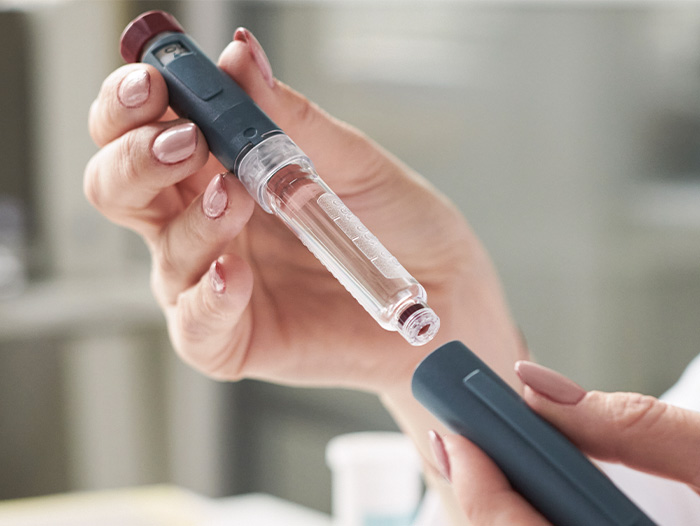Auto logout in seconds.
Continue LogoutDemand for obesity drugs has reached a "fever pitch," but drugmakers are struggling to meet it. And while increased competition — including FDA approval of Eli Lilly's Zepbound and AstraZeneca's development progress — could provide some relief, Advisory Board's Chloe Bakst and Rachael Peroutky predict when the shortage might end (and share what leaders can do in the meantime).
GLP-1 supply lags behind skyrocketing demand
Despite record sales and efforts to boost production, the United States is experiencing a shortage of obesity drugs.
Last week, Novo Nordisk announced record operating profits for the third quarter, with $1.36 billion in Wegovy sales — a 28% increase over the previous quarter. In 2024, Novo Nordisk said it expects to see double-digit sales growth for both Wegovy and Ozempic.
"We'll be supplying significantly more in 2024 compared to what we are in 2023," said Novo Nordisk CFO Karsten Munk Knudsen.
Meanwhile, Eli Lilly reported $1.41 billion in Mounjaro sales during the third quarter. And while the drug maker said its U.S. supply has started to improve after a monthslong shortage, it noted that it is still working to increase production to meet growing demand. The company hopes to double last year's supply capacity by the end of the year.
"With all the investments we're making and the production plans, the expected demand for (Mounjaro) will be quite significant. So we can be in a tight situation for some time," said Eli Lilly CFO, Anat Ashkenazi.
Since its approval in May 2022, Mounjaro has become increasingly popular as an off-label treatment for obesity. Now, patients will have access to a new obesity drug: On Wednesday, FDA approved Eli Lilly's Zepbound, which contains tirzepatide, the same active ingredient in Mounjaro.
According to Scott Hagan, an assistant professor of medicine at the University of Washington, Zepbound is now likely the most effective obesity treatment on the market.
"In light of increasing rates of both obesity and overweight in the United States, today's approval addresses an unmet medical need," said John Sharretts, director of the Division of Diabetes, Lipid Disorders, and Obesity in FDA's Center for Drug Evaluation and Research.
"It's very similar to what we went through with Ozempic," said Andrew Kraftson, a clinical associate professor in the division of metabolism, endocrinology, and diabetes at Michigan Medicine, adding that demand for these drugs has hit a "fever pitch." Now, he predicts that patients will be even more eager to get their hands on Eli Lilly's new drug.
As demand for obesity drugs persists, the global anti-obesity market will be worth roughly $77 billion by 2030, according to a recent forecast from Morgan Stanley.
AstraZeneca is also competing to enter the weight loss drug market. It currently has two early-stage injectable obesity drugs in development, and on Thursday, the company announced it has licensed an anti-obesity pill from China's Eccogene that is currently still in clinical trials.
However, supply issues are expected to continue playing a significant role in companies' growth.
To keep up with the growing demand, drug makers must invest in factories that can take years to construct. Injectable obesity drugs, including Mounjaro, Ozempic, and Wegovy, are complex to manufacture.
However, oral medications are much simpler to manufacture. According to analysts from Morgan Stanley, the supply constraints surrounding obesity drugs may only be truly resolved when oral alternatives enter the market. (Wainer, Wall Street Journal, 11/2; Fick/Satija, Reuters, 11/2; Constantino, CNBC, 11/2; Eli Lilly news release, 11/8; Chen/Garde, STAT, 11/8; Blum, New York Times, 11/8; Kollewe, The Guardian, 11/9)
What leaders can do to address GLP-1 shortages
By Chloe Bakst and Rachael Peroutky
The shortage of obesity drugs has created a pressing challenge within the healthcare industry, affecting patients, providers, pharmacies, and payers alike. Healthcare leaders must understand the implications of this extended shortage and take proactive steps to mitigate its impact.
Here's our take on how an extended shortage could impact stakeholders, what healthcare leaders can do to respond, and how long the shortage will last.
What are the implications of an extended shortage?
An extended shortage of obesity drugs will have a widespread impact across the entire healthcare system. Here's how we think an ongoing shortage will impact four key players.
Patients
As they have already, patients will feel the brunt of the impact as access issues continue. Not only are patients with new prescriptions frustrated as they wait to start treatment, but current patients' health can worsen if they are forced to cycle on and off the drugs. Shortages could also exacerbate weight bias if people using the medication to treat obesity are blamed to some extent for the access struggles.
Providers
Providers will feel the burden too. Prescribers must keep track of which drugs and doses are available at a given time and field calls from patients and pharmacies when drugs are unavailable. They must also consider whether off-label prescribing might be appropriate, or even possible, given a patient's insurance coverage.
Pharmacies
Pharmacies spend significant time managing patients and supply chains for drugs in shortage. The extended shortage will continue to exacerbate challenges of under-staffing and over-work that's led to recent pharmacist walkouts and closures.
Payers
The shortage will also limit payers' ability to negotiate down costs. Usually, increased competition, such as the launch of Eli Lilly's weight management drug Zepbound, would strengthen payers' negotiation power. But given the shortage of both products and the high demand for these medications, manufacturers may still have the upper hand. Shortages of critical drugs also limit payers' ability to restrict the formulary to only one or a few drugs in a class.
What can healthcare leaders do during the shortage?
Health system and provider leaders should consider how they can integrate comprehensive obesity treatment into patients' care plans even if patients are unable to access GLP-1 medications. Managing chronic obesity depends on more than access to a medication, and providers are finding a growth opportunity as demand for weight management drugs has fed demand for obesity services overall.
Healthcare leaders can educate providers on obesity care and weight bias, create referral pathways, and improve coordination across medical, surgical, and behavioral interventions for patients seeking obesity care management.
These actions will build the infrastructure providers need to offer comprehensive care, even in the face of drug shortages, strict prior authorization requirements, or other factors that limit patients' access to GLP-1s.
Meanwhile, payers and employers should consider how they are supporting their members outside of access to medications. The shortage presents an opportunity to evaluate the current diabetes and weight management offerings and assess whether the infrastructure is in place to support members holistically, even after access to the medications improves.
Health plans should consider how they can partner with providers to control costs and ensure proper utilization. One approach is where health plans require patients to receive care from providers who are trained in managing obesity care and who can provide wrap-around services to support the long-term success of the patient, on and off the drug.
When will the shortage end?
Competition will provide some relief for diabetes and obesity patients alike, with more product options and different active ingredients. However, supply chain concerns and persistently high demand will still make it challenging for patients to fill their prescriptions.
Lilly's Zepbound is likely to have the same difficulties meeting demand and manufacturing delays as its sister medication Mounjaro, which is currently on FDA's shortage list. Looking ahead, the oral version of Wegovy is expected at the end of 2024 and won't have to manage some of the supply chain issues that the injectable medications have — though it's possible that other production challenges could arise.
Realistically, shortages are not going away — and neither is demand. Healthcare leaders need to listen to patients, understand their health goals, and create multiple options for patients to work toward their health goals while the pharmaceutical pipeline catches up.
Don't miss out on the latest Advisory Board insights
Create your free account to access 1 resource, including the latest research and webinars.
Want access without creating an account?
You have 1 free members-only resource remaining this month.
1 free members-only resources remaining
1 free members-only resources remaining
You've reached your limit of free insights
Become a member to access all of Advisory Board's resources, events, and experts
Never miss out on the latest innovative health care content tailored to you.
Benefits include:
You've reached your limit of free insights
Become a member to access all of Advisory Board's resources, events, and experts
Never miss out on the latest innovative health care content tailored to you.
Benefits include:
This content is available through your Curated Research partnership with Advisory Board. Click on ‘view this resource’ to read the full piece
Email ask@advisory.com to learn more
Click on ‘Become a Member’ to learn about the benefits of a Full-Access partnership with Advisory Board
Never miss out on the latest innovative health care content tailored to you.
Benefits Include:
This is for members only. Learn more.
Click on ‘Become a Member’ to learn about the benefits of a Full-Access partnership with Advisory Board
Never miss out on the latest innovative health care content tailored to you.




